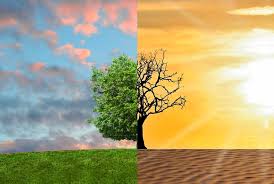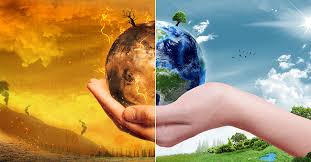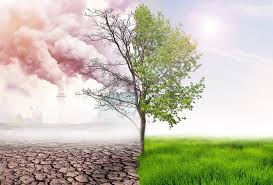This article explains the impacts of climate change on the environment, with a focus on atmospheric structure, global warming, climate patterns, weather systems, and ecological concepts.
Each section is tailored to help readers understand how climate and environmental elements interact and the implications for ecosystems and human activity.
Read Also: The Soybean Epicotyl: Economic Importance, Uses, and By-Products
Atmosphere, Climate, and Weather

The Earth’s atmosphere is a thin layer of gases held by gravity and is essential for sustaining life. Dry air is composed of approximately 78% nitrogen, 21% oxygen, and 1% argon, with trace gases like carbon dioxide and methane contributing to the greenhouse effect. Suspended particles such as dust, sea spray, and industrial pollutants may also be present.
The ozone layer within the atmosphere shields life from harmful ultraviolet (UV) radiation. Additionally, the atmosphere moderates surface temperature by retaining heat at night.
Atmospheric Layers
A. Principal Layers
1. Exosphere: The outermost layer, mainly composed of hydrogen and helium, begins at the exobase and extends into space.
2. Thermosphere: Ranges from 350–800 km above the Earth, this layer contains the International Space Station.
3. Mesosphere: Extends up to 85 km and is where most meteors burn upon entry.
4. Stratosphere: Lies above the troposphere up to about 51 km and houses the ozone layer.
5. Troposphere: The lowest layer, where weather occurs, extends up to 17 km at the equator and 7 km at the poles.
B. Other Layers
1. Ozone Layer: Found in the lower stratosphere (15–35 km), it absorbs the majority of UV radiation.
2. Ionosphere: Overlaps the thermosphere and exosphere and is ionized by solar radiation.
3. Homosphere and Heterosphere: The homosphere includes the troposphere to mesosphere, while the heterosphere begins above and is hydrogen-dominated.
4. Planetary Boundary Layer: The part of the troposphere influenced by Earth’s surface through turbulence.
Effects of Global Warming

Global warming is largely driven by human activities that release greenhouse gases. These gases intensify the greenhouse effect, altering climate patterns and affecting ecosystems, agriculture, and human societies.
Major international initiatives includ:
1. United Nations Framework Convention on Climate Change (UNFCCC): Aims to stabilize greenhouse gas concentrations.
2. Kyoto Protocol: A commitment by nations to reduce emissions.
3. Western Climate Initiative: A regional effort using market-based systems to cut emissions.
Researchers are working to distinguish natural climate variability from anthropogenic changes and to develop adaptive strategies for ecosystems and societies.
Climate
Climate is defined by long-term averages of temperature, humidity, pressure, wind, and precipitation. Unlike weather, which is short-term, climate patterns span decades.
Two classification systems are commonly used
1. Köppen Classification: Based on temperature and precipitation.
2. Thornthwaite System: Considers evapotranspiration, useful in biodiversity and climate impact studies.
Weather
Weather describes short-term atmospheric conditions. Most phenomena occur in the troposphere. Weather patterns are driven by solar energy, latitude, air pressure, and jet streams. Seasonal variations result from Earth’s axial tilt. Forecasting involves scientific tools to predict atmospheric conditions over short periods.
Read Also: The Soybean Epicotyl: Economic Importance, Uses, and By-Products
Life and the Biosphere

Life has existed for about 3.7 billion years and is characterized by metabolism, growth, adaptation, and reproduction. All living organisms, from microbes to plants and animals, are interconnected within the biosphere and contribute to Earth’s ecological balance.
Ecosystems
An ecosystem includes all living organisms (biotic) and their non-living (abiotic) environment. Ecosystems function through energy flow, nutrient cycling, and interactions among species.
Key points include:
1. Diversity enhances resilience.
2. Human activities influence ecosystems, creating urban and semi-natural systems.
3. Natural and human ecosystems are interconnected.
Biomes
Biomes are regions defined by climate and dominant vegetation, such as deserts, forests, and grasslands. Unlike ecozones, biomes focus on plant forms and climate rather than genetics or historical distribution.
Biogeochemical Cycles
Essential cycles include:
1. Nitrogen Cycle: Movement of nitrogen through air, soil, and living organisms.
2. Water Cycle: Continuous movement of water in various states.
3. Carbon Cycle: Exchange of carbon between Earth’s systems.
4. Oxygen Cycle: Driven by photosynthesis, maintaining breathable air.
5. Phosphorus Cycle: Movement of phosphorus through land, water, and living systems.
Wilderness and Wildlife
Wilderness areas are regions untouched by significant human modification. These are vital for biodiversity, conservation, and scientific research. Wildlife exists in all ecosystems and is increasingly affected by human influence.
Environmental Challenges and Goals
Environmental science focuses on minimizing pollution and preserving ecosystems. Major goals include:
1. Reducing pollution to zero levels.
2. Converting waste to energy.
3. Promoting renewable energy sources.
4. Conserving water, land, and air.
5. Protecting biodiversity and endangered species.
Large infrastructure projects, such as dams, pose growing threats to natural environments, emphasizing the need for sustainable development.
Do you have any questions, suggestions, or contributions? If so, please feel free to use the comment box below to share your thoughts. We also encourage you to kindly share this information with others who might benefit from it. Since we can’t reach everyone at once, we truly appreciate your help in spreading the word. Thank you so much for your support and for sharing!

